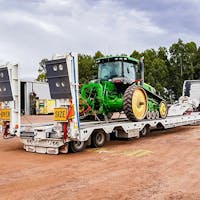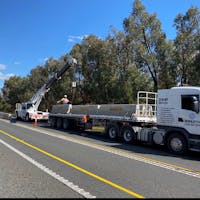Find the Best Low Loader Suppliers Near You
- Post a job
- Receive multiple quotes
- Choose your preferred Low Loader supplier
Where do you need Low Loader Hire?
Describe your job and our suppliers will send you quotes
Popular Low Loader Hire Locations
300+ Low Loaders for Hire on iseekplant
Transport your heavy machinery with ease. iseekplant offers a diverse range of well maintained fleet of low loaders for hire. Whether you need a dry hire or wet hire option, our platform connects you with reliable suppliers. From construction equipment to oversized items, our suppliers and their specialised low loaders can handle any transport challenge.
Low Loader Hire Rates Guide
The table below is a general guide to the daily, weekly, and monthly hire rates to help you budget for your project’s needs:
| Low Loader Type | Size | Daily Hire Rate | Weekly Hire Rate | Monthly Hire Rate |
|---|---|---|---|---|
| Standard Low Loader | Up to 15t | $400 - $600 | $1,600 - $2,400 | $6,400 - $9,600 |
| Extendable Low Loader | 16t – 30t | $450 - $650 | $1,800 - $2,600 | $7,200 - $10,400 |
| Drop Deck Low Loader | 31t - 50t | $500 - $700 | $2,000 - $2,800 | $8,000 - $11,200 |
| Gooseneck Low Loader | 51t - 70t | $550 - $750 | $2,200 - $3,000 | $8,800 - $12,000 |
| Widening Low Loader | Over 70t | $600 - $800 | $2,400 - $3,200 | $9,600 - $12,800 |
| Dolly Low Loader | Up to 100 Tonnes | $650 - $850 | $2,600 - $3,400 | $10,400 - $13,600 |
Note: All prices listed are estimates, exclude GST and are in AUD. Prices are estimates and can vary based on location, model and additional requirements.
Additional Costs to Consider When Hiring Low Loaders
When planning to hire a low loader, you’ll need to account for more than just the base hire rate. Here are several additional costs that can influence your budget:
| Additional Cost | Standard Rate | Description |
|---|---|---|
| Insurance | 3% - 7% of hire cost | Covers damage to the low loader or third-party property. |
| Mobilisation/Demobilisation | $600 - $1800 | Cost for delivering the low loader to your site and returning it. |
| Permit Fees | $150 - $700 | Required for transporting oversized loads or using certain roads. |
| Escort Vehicles | $250 - $700 per day | Necessary for oversized loads to ensure safety and compliance. |
| Standby Charges | $150 - $400 per day | Fees for keeping the low loader on standby beyond the initial hire period. |
Considering these additional expenses early on can provide a more accurate picture of the total cost involved in hiring a low loader. Use our Get a Quote tool to connect with our suppliers to get a customised quote for your project today!
Comparing Different Types of Low Loaders
Low loaders are essential for transporting heavy equipment across various industries, including construction and agricultural machinery. Different low loader types cater to specific transport requirements.
- Standard Low Loaders: Ideal for general-purpose heavy equipment transport.
- Drop Deck Low Loaders: Perfect for oversized equipment that requires additional clearance.
- Extendable Low Loaders: Designed for extra-long loads, such as wind turbine blades and long structural beams.
- Gooseneck Low Loaders: Ideal for self-propelled equipment like excavators and bulldozers.
- Widening Low Loaders: Accommodate wide loads by extending the deck width.
Dolly Low Loaders: Distribute weight over multiple axles for extremely heavy or long loads, improving manoeuvrability and reducing strain on the prime mover. Consider factors like deck lengths and load capacity when selecting the right low loader for your specific needs.
Key Features, Specs, Pros and Cons of Popular Low Loaders
When choosing a low loader, like any piece of heavy machinery, selecting the right brand and model is crucial. Here's a comparison of popular low loader types:
| Low Loader Type | Popular OEM & Model | Technical Specs | Capacity | Pros | Cons |
|---|---|---|---|---|---|
| Standard Low Loader | Maxitrans ST3 | Tri-axle, hydraulic ramps | Up to 45 Tonnes | Highly versatile for a range of loads | May not suit very long or tall equipment |
| Drop Deck Low Loader | Kenworth C500 | Hydraulic gooseneck, drop deck | Up to 40 Tonnes | Lower deck height for tall loads | Limited by length for extremely long cargo |
| Extendable Low Loader | TRT Quad Axle | Extendable deck up to 20 metres | Up to 50 Tonnes | Adjustable length for long loads | Complex operation; higher cost |
| Gooseneck Low Loader | Goldhofer STZ-L5 | Detachable gooseneck, hydraulic suspension | Up to 60 Tonnes | Easy loading of machinery; good weight distribution | Requires space for detachment and attachment |
| Widening Low Loader | Freighter T-Liner | Hydraulic widening up to 3.5 metres | Up to 70 Tonnes | Wide load capability for large machinery | Requires careful handling on narrow roads |
| Dolly Low Loader | Vawdrey Australia Dolly | Dolly converter with multiple axles | Up to 100 Tonnes | Adds flexibility and capacity to standard trailers | Additional licensing and skill to operate |
Low Loaders, Drop Decks, Floats & Beaver Tails – What Truck Do you Need?
The type of truck you choose can significantly impact the ease of loading, transit safety and unloading efficiency. Whether you're moving an excavator, towering machinery or a medium-sized dozer, understanding the differences between low loaders, drop decks, floats and beaver tails can ensure a seamless transport experience.
Here’s a quick rundown between these options:
| Truck Type | Best For | Why? |
|---|---|---|
| Low Loaders | Heavy machinery | Their low deck height makes loading and offloading quick and easy. |
| Drop Decks | Tall equipment | They are similar to low loaders with two deck levels. The top level is removable, which is ideal for tall equipment. |
| Floats | Mining equipment | These pieces are perfect for handling extreme weights. |
| Beaver Tails | Medium-sized equipment | Their sloping rears are ideal for driving equipment such as excavators or dozers and loading them onto the trailer. |
Your choice should reflect the machinery's size, weight and loading/unloading requirements.
Seamlessly Transport Your Heavy Loads with Low Loaders on iseekplant
When it comes to moving oversized equipment, precision and safety are paramount. iseekplant makes hiring low loaders simple and efficient. Our network spans Australia, connecting you to a wide selection of low loader suppliers, each vetted for reliability and service quality, perfectly matching your project's specific transportation needs. Post your job requirements and get multiple quotes from trusted professionals.
And if you're looking for comprehensive transport solutions, we've got you covered with additional services, including pilot vehicles and escort services, to ensure your cargo arrives without a hitch.
For any questions or to get personalised assistance, don't hesitate to contact us at projects@iseekplant.com.au or give us a call at 1300 691 912. If you're ready to streamline your heavy haulage process, click 'Get a Quote' and let us connect you with the best in the business.
Become a supplier
Recent Low Loader Hire reviews
"We would like to thank the guys at Gravity for lifting in our pool. They were very easy to deal with and very helpful and would recommend then to anyo..."
- NatashaView profileHow It Works
Low Loader Hire FAQs
Here are some frequently asked questions and tips on finding the right low loader supplier for your job.


